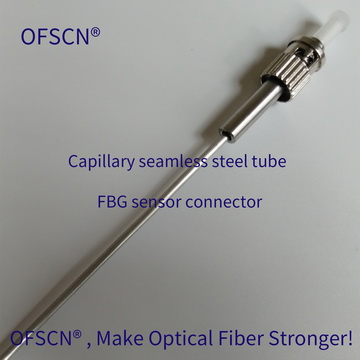Femtosecond FBG - Femtosecond Laser Write FBG - Femtosecond FBG Sensor - Concept Classification Advantages Disadvantages Difficulties - Principle Parameters Video Purchase Price
Table of Contents:
Ⅰ. What is a Femtosecond Fiber Bragg Grating?
A Femtosecond Fiber Bragg Grating (FBG) is a special type of FBG produced using femtosecond laser as the processing light source. It is commonly referred to as a Femtosecond Fiber Bragg Grating (femtosecond FBG).

Ⅱ. Classification of Femtosecond Fiber Bragg Gratings
Femtosecond Fiber Bragg Gratings are just one method of producing FBGs. This FBG production method has been mastered by many companies in different countries.
1. Classification based on different femtosecond laser writing methods:
Femtosecond laser mask writing fiber gratings
Femtosecond laser point-by-point writing fiber gratings, etc.
2. Classification based on the number of sensing points of femtosecond FBGs on the fiber:
Single-point femtosecond fiber Bragg gratings
Multi-point femtosecond fiber Bragg gratings (femtosecond FBG strings/arrays), etc.

3. Classification based on the reflectivity of femtosecond fiber Bragg gratings:
Conventional femtosecond fiber Bragg gratings (around 50% reflectivity)
Low-reflectivity femtosecond fiber Bragg gratings (around 25% reflectivity)
High-reflectivity femtosecond fiber Bragg gratings (around 75% reflectivity) - High-reflectivity femtosecond FBGs may cause greater fiber damage, affecting the lifespan of femtosecond FBGs.
4. Classification based on the type of fiber used for writing femtosecond FBGs:
Polypropylene femtosecond fiber Bragg gratings
Polyimide femtosecond fiber Bragg gratings , etc.
DCYS can customize various types of Femtosecond Fiber Bragg Gratings.
Ⅲ. What is a Femtosecond Fiber Bragg Grating Sensor and its classification?
1. What is a Femtosecond Fiber Bragg Grating Sensor?
A Femtosecond Fiber Bragg Grating Sensor refers to an FBG sensor encapsulating a femtosecond fiber Bragg grating.
2. Classification of Femtosecond Fiber Bragg Grating Sensors:
Apart from the different fiber grating writing methods used in the sensors, there is not much difference between Femtosecond Fiber Bragg Grating Sensors and regular Fiber Bragg Grating Sensors. Therefore, conventional types of fiber Bragg grating sensors can be produced as corresponding Femtosecond Fiber Bragg Grating Sensors, such as Femtosecond Fiber Bragg Grating Temperature Sensors, Strain Sensors, Stress Sensors, Vibration Sensors, Displacement Sensors, and Tensile Force Sensors, if there is a special need.
DCYS can customize various types of Femtosecond Fiber Bragg Grating Sensors.
Ⅳ. Advantages of Femtosecond Fiber Bragg Gratings, and when to use them to produce Femtosecond Fiber Bragg Grating Sensors.
Femtosecond Fiber Bragg Gratings have an advantage over conventional UV photomask methods in high-temperature resistance. Therefore, when customers need to test temperatures above 400°C, we produce Femtosecond Fiber Bragg Grating Temperature Sensors. The OFSCN® Femtosecond FBG Temperature Sensor produced by DCYS uses patented stainless steel seamless tube encapsulation technology for femtosecond laser point-by-point written optical fiber gratings, ensuring high-temperature resistance.
 |
 |
Ⅴ. Principle of Sensing using Femtosecond Fiber Bragg Gratings.
Femtosecond Fiber Bragg Gratings utilize femtosecond laser to produce FBGs, and the principle of using them for fiber grating sensing is not different from conventional methods. The sensing principle is as follows:
Ⅵ. Video of Femtosecond Fiber Bragg Gratings and Femtosecond Fiber Bragg Grating Temperature Sensors.
The physical videos of Femtosecond Fiber Bragg Gratings and Femtosecond Fiber Bragg Grating Temperature Sensors produced by DCYS are as follows:
Ⅶ. Parameters of Femtosecond Fiber Bragg Gratings.
When selecting Femtosecond Fiber Bragg Gratings, it is necessary to consider parameters such as reflectivity (typical values: high reflectivity around 75%, medium reflectivity around 50%, low reflectivity around 25%), grating length (typical values: 10mm, 5mm, 3mm, 1mm), and 3dB bandwidth (between 0.25nm and 2.0nm).
Ⅷ. How to purchase Femtosecond Fiber Bragg Gratings, and key points for selection.
The reflectivity, grating length, and 3dB bandwidth of Femtosecond Fiber Bragg Gratings are often interrelated and may affect each other. When one parameter changes, the other two may also change accordingly. Therefore, it is necessary to make a reasonable selection to achieve a balance between the parameters. If you are unsure how to choose, please contact DCYS, and we will assist you in making the selection.
Ⅸ. Disadvantages of Femtosecond Fiber Bragg Gratings, and misconceptions in their use.
The main drawback of Femtosecond Fiber Bragg Gratings is that they tend to have higher prices, which may result in a lower cost-effectiveness when used as bare fiber gratings or encapsulated into fiber grating sensors. It is important to note that the production method of femtosecond laser point-by-point written fiber gratings is just one of the methods for producing fiber Bragg gratings. Femtosecond Fiber Bragg Gratings are fundamentally no different from fiber Bragg gratings produced by other methods. Therefore, it is essential to make a rational choice based on your specific needs and use them properly.
In addition, unlike mature UV photomask produced fiber gratings, most femtosecond fiber gratings produced in the production line lack post-aging treatment. Therefore, using them directly after purchase may lead to some usage misunderstandings.
Ⅹ. Prices of Femtosecond Fiber Bragg Gratings and Femtosecond Fiber Bragg Grating Sensors.
Since the complex production process of Femtosecond Fiber Bragg Gratings, their prices are often higher than those of fiber gratings produced by UV photomask methods. Consequently, the prices of Femtosecond Fiber Bragg Grating Sensors utilizing femtosecond fiber Bragg gratings are also higher. You can contact us to inquire about different quotations for various purchasing quantities.
Ⅺ. Other related information on Femtosecond Fiber Bragg Gratings and Femtosecond Fiber Bragg Grating Sensors.
Due to the low likelihood of degradation of femtosecond fiber Bragg gratings at high temperatures, combined with DCYS's patented "stainless steel seamless tube encapsulation technology," DCYS's OFSCN® Femtosecond FBG Sensors can meet high-temperature measurement requirements of up to 1000°C, making them highly popular as high-temperature resistant FBG sensors in the market. Moreover, DCYS's OFSCN® Femtosecond FBG Sensors can also work in environments as cold as -200°C, making them stable and low-temperature resistant FBG sensors.
For more information on Femtosecond Fiber Bragg Gratings and Femtosecond Fiber Bragg Grating Sensors, including working temperature, wavelength parameters, calibration information, and actual images, please refer to the following articles.
